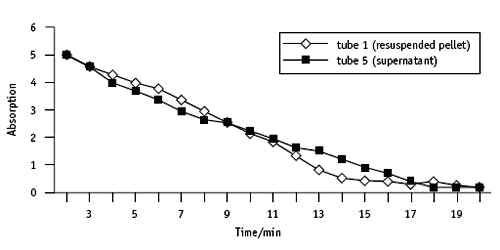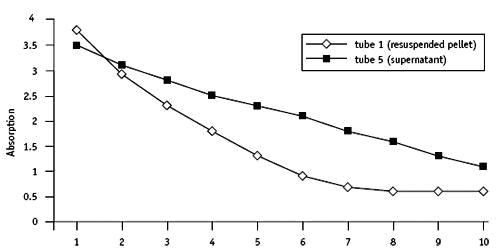
A collection of experiments that demonstrate biological concepts and processes.
It is fairly easy to show that plants produce oxygen and starch in photosynthesis. At age 14–16 students may have collected the gas given off by pond weed (for example Elodea) and tested leaves for starch.
It is not quite so easy to demonstrate the other reactions in photosynthesis. For the reduction of carbon dioxide to carbohydrate there must be a source of electrons. In the cell, NADP is the electron acceptor which is reduced in the light-dependent reactions, and which provides electrons and hydrogen for the light-independent reactions.
In this investigation, DCPIP (2,6-dichlorophenol-indophenol), a blue dye, acts as an electron acceptor and becomes colourless when reduced, allowing any reducing agent produced by the chloroplasts to be detected.
This investigation depends on working quickly and keeping everything cool. Your students will need to understand all the instructions in advance to be sure that they know what they are doing.
Centrifuge – with RCF between 1500 and 1800g
Fresh green spinach, lettuce or cabbage, 3 leaves (discard the midribs)
Cold pestle and mortar (or blender or food mixer) which has been kept in a freezer compartment for 15–30 minutes (if left too long the extract will freeze)
Muslin or fine nylon mesh
Glass rod or Pasteur pipette
Measuring cylinder, 20 cm 3
Beaker, 100 cm 3
Pipettes, 5 cm 3 and 1 cm 3
Bench lamp with 100 W bulb
Pipette for 5 cm 3
Pipette for 0.5 cm 3
Waterproof pen to label tubes
Colorimeter and tubes or light sensor and data logger
0.05 M phosphate buffer solution, pH 7.0: Store in a refrigerator at 0–4 °C (Note 1).
Isolation medium (sucrose and KCl in phosphate buffer): Store in a refrigerator at 0–4 °C (Note 2).
Potassium chloride (Low Hazard) (Note 3).
DCPIP solution (Low Hazard): (1 x 10 - 4 M approx.) (Note 4)
Although DCPIP presents minimal hazard apart from staining, it is best to avoid skin contact in case prolonged contact with the dye causes sensitisation.
Do not handle electric light bulbs with wet hands.
All solutions used are low hazard – refer to relevant CLEAPSS Hazcards and Recipe cards for more information.
1 0.05 M phosphate buffer solution, pH 7.0. Na2HPO4.12H2O, 4.48 g (0.025 M) KH2PO4, 1.70 g (0.025 M). Make up to 500 cm 3 with distilled water and store in a refrigerator at 0–4 °C. Low hazard – refer to CLEAPSS Hazcard 72.
2 Isolation medium. Sucrose 34.23 g (0.4 M) KCl 0.19 g (0.01 M). Dissolve in phosphate buffer solution (pH 7.0) at room temperature and make up to 250 cm 3 with the buffer solution. Store in a refrigerator at 0–4 °C. Low hazard – refer to CLEAPSS Hazcard 40C.
3 Potassium chloride 0.05 M. Dissolve 0.93 g in phosphate buffer solution at room temperature and make up to 250 cm 3 . Store in a refrigerator at 0–4 °C. Use at room temperature.(Note that Potassium chloride is a cofactor for the Hill reaction.) Refer to CLEAPSS Hazcard 47B and Recipe card 51.
4 DCPIP solution DCPIP 0.007–0.01 g, made up to 100 cm 3 with phosphate buffer. Refer to CLEAPSS Hazcard 32 and Recipe card 46.
Keep solutions and apparatus cold during the extraction procedure, steps 1–8, to preserve enzyme activity. Carry out the extraction as quickly as possible.
Preparation
a Cut three small green spinach, lettuce or cabbage leaves into small pieces with scissors, but discard the tough midribs and leaf stalks. Place in a cold mortar or blender containing 20 cm 3 of cold isolation medium. (Scale up quantities for blender if necessary.)
b Grind vigorously and rapidly (or blend for about 10 seconds).
c Place four layers of muslin or nylon in a funnel and wet with cold isolation medium.
d Filter the mixture through the funnel into the beaker and pour the filtrate into pre-cooled centrifuge tubes supported in an ice-water-salt bath. Gather the edges of the muslin, wring thoroughly into the beaker, and add filtrate to the centrifuge tubes.
e Check that each centrifuge tube contains about the same volume of filtrate.
f Centrifuge the tubes for sufficient time to get a small pellet of chloroplasts. (10 minutes at high speed should be sufficient.)
g Pour off the liquid (supernatant) into a boiling tube being careful not to lose the pellet. Re-suspend the pellet with about 2 cm 3 of isolation medium, using a glass rod. Squirting in and out of a Pasteur pipette five or six times gives a uniform suspension.
h Store this leaf extract in an ice-water-salt bath and use as soon as possible.
Investigation using the chloroplasts
Read all the instructions before you start. Use the DCPIP solution at room temperature.
i Set up 5 labelled tubes as follows.
Leaf extract (cm 3 )
Supernatant (cm 3 )
Isolation medium (cm 3 )
Distilled water (cm 3 )
DCPIP solution (cm 3 )
j When the DCPIP is added to the extract, shake the tube and note the time. Place tubes 1, 2 and 4 about 12–15 cm from a bright light (100 W). Place tube 3 in darkness.
k Time how long it takes to decolourise the DCPIP in each tube. If the extract is so active that it decolourises within seconds of mixing, dilute it 1:5 with isolation medium and try again.
Traditionally the production of oxygen and starch are used as evidence for photosynthesis. The light-dependent reactions produce a reducing agent. This normally reduces NADP, but in this experiment the electrons are accepted by the blue dye DCPIP. Reduced DCPIP is colourless. The loss of colour in the DCPIP is due to reducing agent produced by light-dependent reactions in the extracted chloroplasts.
Students must develop a clear understanding of the link between the light-dependent and light-independent reactions to be able to interpret the results. Robert Hill originally completed this investigation in 1938; he concluded that water had been split into hydrogen and oxygen. This is now known as the Hill reaction.
You can examine a drop of the sediment extract with a microscope under high power to see chloroplasts. There will be fewer chloroplasts in the supernatant – which decolourises the DCPIP more slowly, reinforcing the idea that the reduction is the result of chloroplast activity.
Sample results
Using a bench centrifuge
The experimental procedure was followed. A standard lab centrifuge was used to spin down the chloroplasts (Clifton NE 010GT/I) at 2650 RPM, 95 X g for 10 minutes.
The experiment was started within 5 minutes of preparing the chloroplasts. The reaction was followed using an EEL colorimeter with a red filter – readings taken every minute.
Absorption Tube 1
Tube 3 (incubated in the dark) gave a reading of 5.4 absorption units after 20 minutes.
Tube 2 (DCPIP with no leaf extract) was 6.2 absorption units.
Using a micro-centrifuge
The experiment was repeated using a micro-centrifuge.
Absorption Tube 1
Tube 3 (incubated in the dark) gave a reading of 4.9 absorption units after 10 minutes.
Tube 2 (DCPIP with no leaf extract) was 6.4 absorption Units.


The relative activity of the pellet was higher than when the bench centrifuge was used. The micro-centrifuge tubes were only 1.5 cm 3 capacity – not ideal for this practical. A higher speed bench centrifuge would be better.
In order to check for loss of chloroplast activity, the experiment was repeated using the same chloroplast suspension 1 and 2 hours after preparation. Chloroplast suspension was kept in a salt-ice bath. There was no loss of activity when the extract was kept in ice for up to 2 hours.
1 Describe and explain the changes observed in the five tubes. Compare the results and make some concluding comments about what they show.
2 The rate of photosynthesis in intact leaves can be limited by several factors including light, temperature and carbon dioxide. Which of these factors will have little effect on the reducing capacity of the leaf extract?
3 Describe how you might extend this practical to investigate the effect of light intensity on the light-dependent reactions of photosynthesis.
Answers
1 Colour change and inferences that can made from the results:
Tube 1 (leaf extract + DCPIP) colour changes until it is the same colour as tube 4 (leaf extract + distilled water).
Tube 2 (isolation medium + DCPIP) no colour change. This shows that the DCPIP does not decolourise when exposed to light.
Tube 3 (leaf extract + DCPIP in the dark) no colour change. It can therefore be inferred that the loss of colour in tube 1 is due to the effect of light on the extract.
Tube 4 (leaf extract + distilled water) no colour change. This shows that the extract does not change colour in the light. It acts as a colour standard for the extract without DCPIP.
Tube 5 (supernatant + DCPIP) no colour change if the supernatant is clear; if it is slightly green there may be some decolouring.
The results should indicate that the light-dependent reactions of photosynthesis are restricted to the chloroplasts that have been extracted.
2 Carbon dioxide will have no effect, because it is not involved in the light-dependent reactions.
3 Students should describe a procedure in which light intensity is varied but temperature is controlled.
Health and safety checked, September 2008